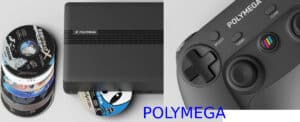Polymega (Hardware) console owns a sizable collection of vintage video games, and up until recently. We played most of them on an imported Retro Freak emulator-based gaming system. It’s a tiny box that can play cartridges from several designs or even rip the games to a micro SD card so you can keep your complete collection on a unit approximately the size of the Super NES disk. However, it does not support disc-based games. In actuality, any consumer retro game system has not yet endorsed disc-based games from the 4th and 5th console generations. All of that is altered by the Playmaji Polymega.One of the most capable consumer-available (not custom-built) retro systems.
This classic game console can play discs for the Sega CD, Sony PlayStation, Neo Geo CD, Sega Saturn, & TurboGrafx 16 from all of their regional releases while also ripping them to installed storage or onboard memory to streamline your collection. With the installation of supplementary Element modules that give the console cartridge slots, it can even play games on cartridges. We’ve seen it is the Polymega, which costs $400 and an additional $60 for each Element module with cartridge compatibility. It deserves the Editors’ Choice award because it is a fantastic toolkit for playing console games from the 4th & 5th generations.
What will you see here?
What is the most recent retro design?
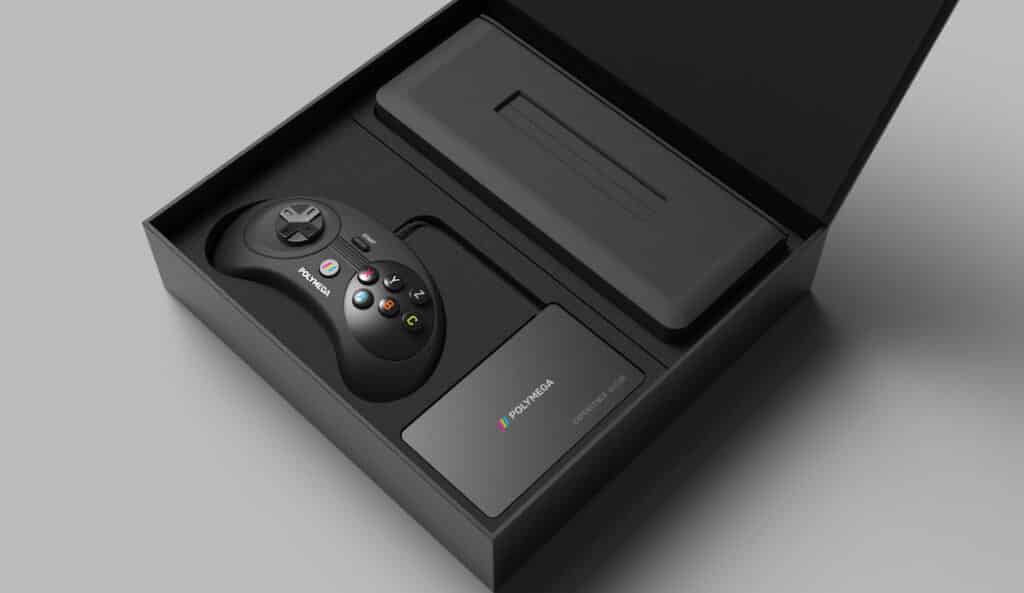
This large box is nearly the size of an Xbox One S and measures 2.2 by 10.2 by 7.8 inches (HWD). Its slot-loading CD-ROM drive is located in the system’s base, and the other components are in the console’s back half. An empty plastic shell covering the front half falls off when a button is pressed. The optional Element modules, which provide cartridge slots and vintage controller ports for other systems, can take the place of this component.
Blocky accessories called element modules, which have controller ports and cartridge slots for various gaming consoles, are the same size & shape as the front shell of the Polymega. Again for Nintendo Entertainment System (NES), Sega Genesis/Mega Drive, Super NES/Super Famicom, and TurboGrafx-16/PC Engine game cards, separate Element modules are available.

Each module includes a wired game controller that is meant to fit into the native controller socket on every module rather than a USB port and is shaped and laid out like the console it supports. To test with the Polymega, Playmaji provided us with the EM02 Super Element set. That is intended for SNES & Super Famicom games.
Polymega (Hardware) console: Controls
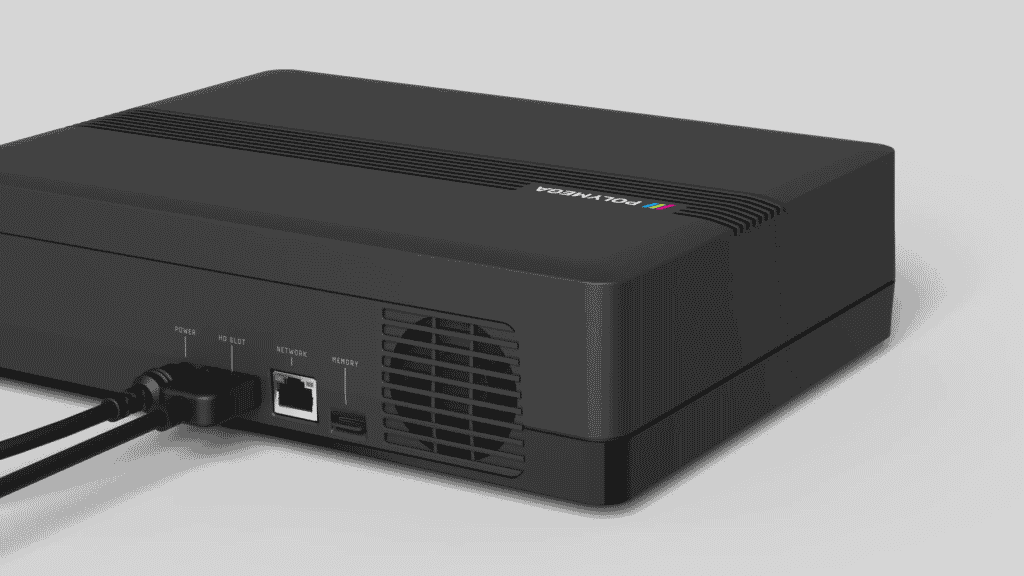
The Polymega includes a standard wireless gamepad with a current dual-analog setup. With a light construction and long trigger pulls, it feels more like a Dualshock 4 than an Xbox controller. One of the 2 USB ports on the system’s front is where the included 2.4GHz USB receiver is positioned. The controller has an excellent build quality and feels comfortable & responsive enough. However, the shiny coating on the control pad makes it slightly slippery. The directional inputs on the place are somewhat less sensitive than they should be.
With two retro pinned ports on the front, each Polymega module is compatible with previous (or replica) gamepads of the support systems. The EM02 Super Element set’s SNES-like controller is a wired controller with a lengthy, 10-foot, fabric-wrapped cord that terminates in a SNES controller port.
Although it has the same famous dogbone design as the SNES gamepad, it has mild, circular bumps on each side of the back for a more comfortable grip. A Polymega button is also there for accessing the system’s menu. This controller’s direction pad is glossy, like the wireless gamepad’s. But it’s bigger and features indentations that give the thumb a bit more grip.
A select few USB controllers from third parties are supported by the Polymega, including the wired and wireless Sega cooperation gamepads from Retro-Bit and the controllers that come with Sega Genesis Mini, Neo Geo Mini, & PlayStation Classic.
Backup and compatibility
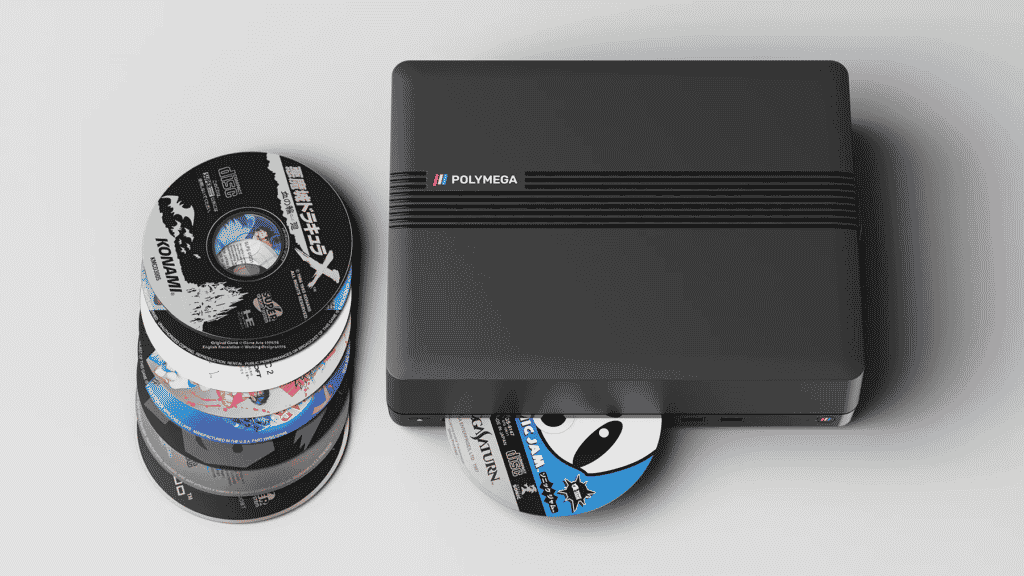
When you turn on the Polymega (Hardware)console, a vibrant, tile-based interface housing the main menu appears. The navigation is simple. Games organize by their systems and divided into different areas (Super Nintendo & Super Famicom games are in various lists).
The Polymega can read games from all regions for the Sony PlayStation, Sega Saturn, Sega CD, TurboGrafx CD, & Neo-Geo CD that you own. As well as the database the system uses to seek the games you import. Simply insert your disc into the slot to begin playing. More importantly & conveniently, you can store your discs on the 32GB of internal storage provided by the Polymega or on a microSD card inserted into the device’s back slot or an M.2 2280 SSD inserted into the device’s bottom. In any case, you’ll need some additional storage. The console only has 9GB of free space when you turn it on between preinstalled games.
The Retro Freak, which acquires from Japan, is the only other retro system with this helpful capability of game backup. The Polymega is the only old-fashioned gaming system that can store backup copies of optical disc-based console games, as the Retro Freak only supports cartridge-based games. Games that have documents to the Polymega bury in a different file system than what is accessible.
For example, by inserting the microSD card into your computer. This implies that you must back up games from your collection of discs and cartridges. Rather than just loading a lot of downloaded game ROMs onto a card, inserting it into the Polymega and starting to play. Contrarily, the Retro Freak allows you to simply upload any game ROMs you desire to its microSD card. Remember, it does not support optical disc or fifth-generation titles.
How to install Polymega (Hardware) console?
Although the installation method is laborious and takes a little over five minutes for each disc, it is effective and worthwhile due to a built-in video game database with hundreds of entries. It automatically recognizes the game you’re installing & displays the box design in the system menu. Nights Into Dreams (Saturn), JoJo’s Bizarre Adventure (PSX), & Mega Man Legends (PSX) all loaded and functioned well after being put on the system. Your library of 16- and 32-bit video games may be loaded onto the Polymega & played without changing discs if you have the patience.
Any cartridge plugged into an Element module linked to a Polymega can also be backed up. It took almost any time to transfer each SNES and Super Famicom game to the system. That is considerably quicker than ripping the games from the CD.
The Polymega (Hardware)console has an internal library of more than 14,000 games for the systems. It can simulate identifying any game you insert. Whether the game launches in North America, Europe, and Japan, the database includes all geographical areas.
Suppose you have a genuine copy of a contest for a console that enables it. Polymega will likely recognize it as soon as you plug it in and display the game’s name and several screenshots.
Issues that encountered
The only issues I encountered were with copies of games that already had English patches installed (a typical practice for Sega CD and Saturn titles, which are much more challenging to locate in their original state than PlayStation games). The Polymega merely stated that Wipeout XL and Policenauts reproduction discs for the Sega Saturn (with English patches) were “Saturn Media.â€. They were still perfectly playable, and it could still load them. But Simply was unable to install them as they lacked any supporting artwork or database information.
You can run any game in “Classic Mode,†which turns off any additional emulator capabilities. With emulator tools activated (mainly save states, for now).
Sound and graphics
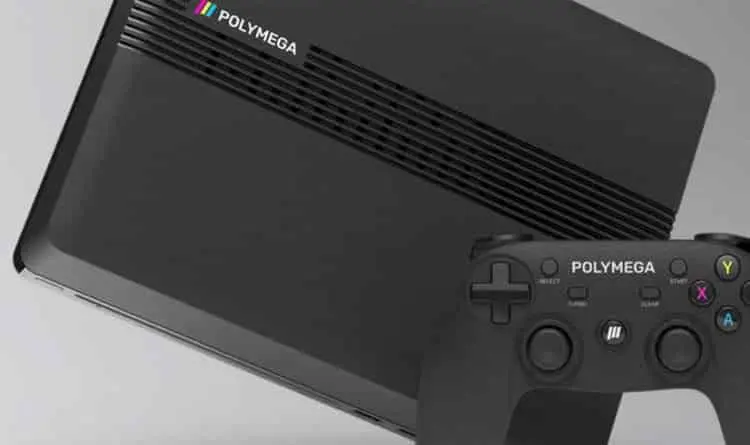
The Polymega is an emulator-based gaming system. That means it mimics the electronics of the game consoles it supports using software emulation and raw computing power (contrasted to FPGA-based systems that emulate those consoles using hardware circuitry, like the Analogue Super Nt & Mega Sg). The majority of retro game systems use emulation. However, some RetroN 5 & Retro Freak have criticized using specific emulation cores without getting consent from the projects which developed them.
Its Mednafen, Mesen, Kega Fusion, & MAME multi-system emulators use by the Polymega. According to Playmaji, internal development is added on top of them.
All emulators render games at their native resolution. But then internally scale them to 1080p, demonstrating the superior system emulation on all fronts. This creates clear, colorful sprites for 2D games that appear just as nice as those from the SNES Classic, Sega Genesis Mini, and TurboGrafX-16 Mini. Apart from two optional scanline filters that simulate RGB & composite video connections and have adjustable contrast & brightness settings to customize how they look. There are no smoothing settings or other graphical filters. That’s a good touch because scanlines typically cause the image to appear noticeably darker than it would in the filter-free view.
Sprite-based games appear nice when rendered at native resolution and appropriately scaled. But you should be ready for 3D games to have noticeable jagged edges. Games with polygonal graphics also output at the native resolution of their respective platforms (640 by 480 for the PlayStation, 256 by 224 for the Saturn), which is then upscaled.
Polymega (Hardware) console: PCSX or Yabuse
Those used for the higher-resolution rendering using emulators such as PCSX or Yabuse. This means that every rough edge upscales along with it and may appear startling. Playmaji intends to enhance Polymega’s operating system in the future to support higher-resolution graphics for 3D games. For the time being, though, you can anticipate any 3D games. You play on the Polymega will appear exactly as if you were playing them on an outdated console, replete with jagged polygonal edges.
Additionally, the audio looks to be excellent. The soundtrack to Tony Hawk’s Pro Skater sounds excellent on the Polymega, and the rough, scratchy sound effects offer lots of substance. The legendary soundtrack of Castlevania: Rondo of Blood likewise sounds fantastic, with no discernible audio jitter or flimsiness.
For collectors of discs

For retro players who want to play fourth- & fifth-generation game consoles on their contemporary TVs, the Polymega (Hardware) is a fantastic console. Although incredibly pricey, it can actually replace all significant regional varieties of the Sega Saturn, Sony PlayStation, Sega CD, Neo Geo CD, & TurboGrafx CD.
Additionally, you may rip your old games to a tiny micro SD card/SSD and keep the whole library close at hand. For NES, SNES, Sega Genesis, & TurboGrafx-16 cartridge support is provided by the Element modules, which are not yet there. There is a tonne of functionality for classic gaming in that one unit.
If you have a strong interest in retro console games and have a strong sense of nostalgia for the 4th and 5th console generations. The Polymega is unquestionably worth taking into account. Whether that’s worth $400 (or $640 if you buy all the Element modules) depends on your perspective on these games. It costs a lot of money.
But it includes many retro game consoles with top-notch 1080p visual output for each one and the capacity to back up whole libraries onto storage. That is sufficient to earn our Editors’ Choice for old-school gaming consoles.
Retro Freak
The Retro Freak is a terrific small Polymega (Hardware)console that you must import or obtain through a reseller. If you just care about cartridge-based games. The Polymega lacks optical disc support, which is mostly what makes it appealing. But it still has a tonne of emulation-based capabilities. Like the ability to back up the entire library to storage. An FPGA-based retro games console, like the Analogue Super Nt and Mega Sg, is the way to go if you’re a purist.
But each console only supports games from a single system, and at $200. They’re not really significantly more affordable than the Polymega when you take supported platforms into account. Retro game compilation devices like the SNES Old and Sega Genesis Mini remain excellent choices. If all you want to do is play some wonderful classic games on your TV without too much hassle or spending a lot of money.
Conclusion
The all-in-one retro game console, Polymega (Hardware)console, is finally delivered on September 12 and launched as the RetroBlox, rename just a few months later, transitioning from FPGA technology to software emulation a year later. But then available for pre-orders a year after that.
That laborious chronology is just part of the battle that developer Playmaji has faced in bringing this device to life. But after nearly a year with a pre-release device, when happy to report that it may have been worthwhile. The Polymega is, after all, an excellent retro gaming console deserving of your attention.
The Polymega is a software-emulation-based console with an Intel-backed custom chipset that runs Linux and has a custom user interface. The hardware contains the standard HDMI, Wi-Fi, Ethernet, USB, and SD card compatibility. As well as a few more unusual additions, such as a CD-ROM drive, support for the tiny but fast m.2 SSD format, plus support for four console-specific expansions known as “Element Modules.” These $80 modules add cartridge and controller support for the NES, Super Nintendo, Genesis, 32X, TurboGrafx-16, and all of their European & Japanese counterparts.
Read more:
- Mechanical Keyboard for Mac in 2020 – 7 Best picks
- Top Lego Sets to enhance your child’s mechanical and scientific development!
- Best Portable CD Players to choose from!
- Adobe Premiere Elements 2022: A platform to create incredible videos!
- How to rip songs from CD to MP3?



